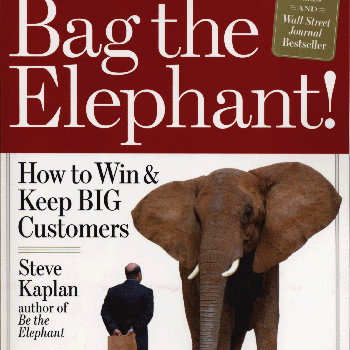- The trail of the snail: This is the first and most conventional approach many entrepreneurs take. It is conservative and cautious, and focuses on simply making a living as an independent business person. Kaplan considers this a lackluster business approach.
- The arc of the shooting star: This is Kaplan’s second example of a business that may have much initial success, but is not sustainable. Kaplan alludes to organizational incompetence and lack of management skills to manage rapid growth. The result all too often, he writes, is failure.
- The “Bag the Elephant” track: This is the theme of the book, giving much anecdotal information on how to seek, find and land the big customer. He describes his own company and numerous others he has helped as a consultant. The descriptions range from a two-woman startup selling promotional materials, to a multi-million transnational organization outsourcing to China.
The reader may be inspired to go hunting for “elephants,” but Kaplan cautions that it takes time, resources, commitment and know-how. He then provides a step-by step approach for the “elephant hunt.”
Overall, I found the book interesting and recommend it to anyone in a slump or with a need to re-energize. However, I found it lacking in serious nuts and bolts advice. Kaplan does not discuss internal capabilities and preparing for readiness. Nor does he give a substantive assessment or need for caution in assessing the rapidly changing external environment. Lastly, the selection of “elephants” requires an in-depth understanding of the health and future of these large clients. In other words, don’t hunt a sick “elephant.” This was sorely lacking in the book and should be remembered when reading this rather engaging book on how to win and keep customers.
Lucia Worthington teaches business and management practices. She considers creative innovations the key to better decision making, survival and success. To recommend a book for review, email bookreviews@vbjusa.com.
{jathumbnail off}

